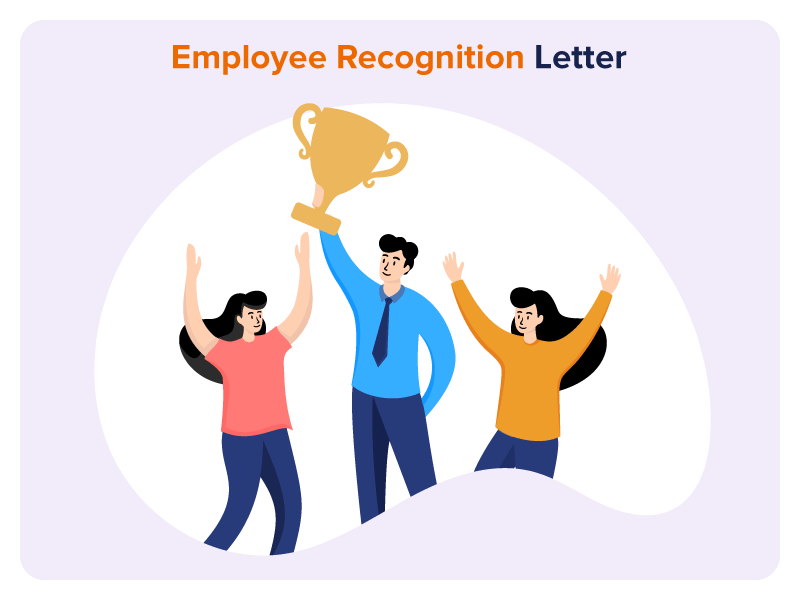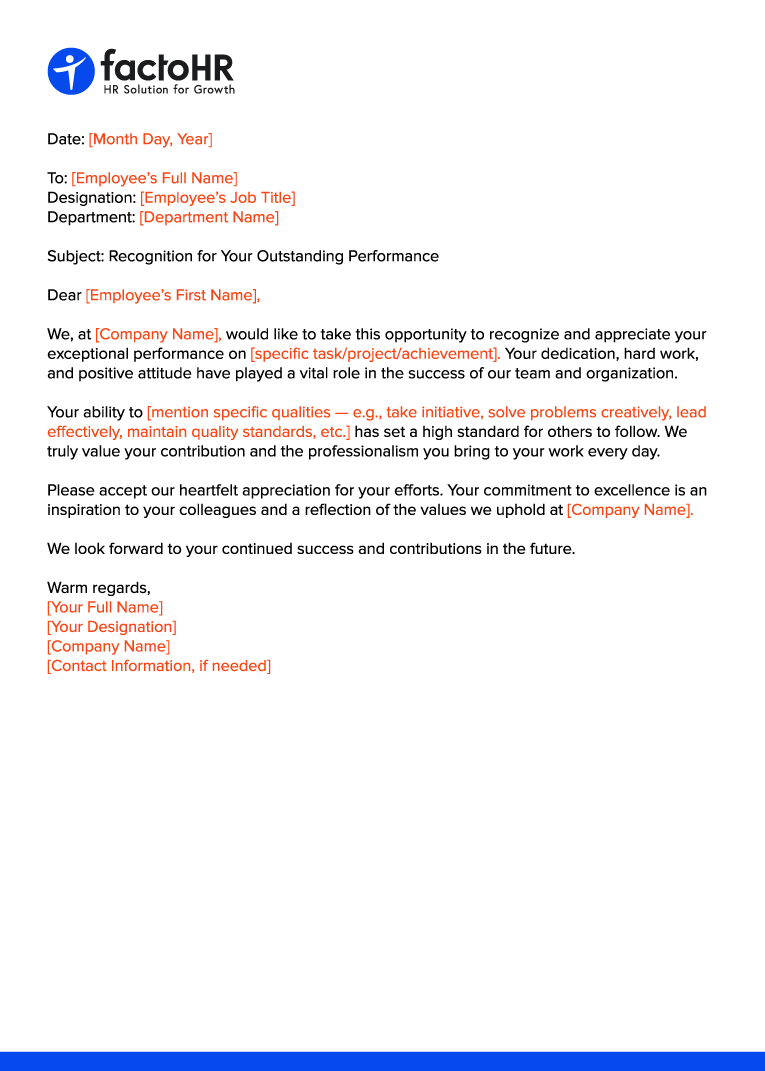Recognition Letter: Format and Templates (How to Write)

Table of Contents
How can organizations recognize employees who consistently go above and beyond in their performance? An employee recognition letter is issued by a company to appreciate an employee’s performance and achievements. The employee letter of recognition sample has been an important part of workplace appreciation. Traditionally, recognition was limited only to annual awards and certificates. These modern methods help celebrate achievements in real-time and increase employee engagement.
This article explains some of the effective ways to write a recognition letter sample for employees. The article also includes some simple templates that organizations can customize according to their needs.

What is an Employee Recognition Letter?
An employee recognition letter is a formal document issued by an organization/manager to an employee to acknowledge and appreciate their hard work. These letters aim to recognize employees’ achievements/performance, which makes them feel motivated for their contributions. Organizations can maintain a positive company culture and improve employee retention by reorganizing employees from time to time.
Employee Recognition Letter Format

Download Standard Format of Employee Recognition Letter in Word

13 Best Examples of Employee Recognition Letters
To create effective recognition letter examples, organizations should include a personalized greeting and a clear statement of the specific achievement that is being recognized. Other details include stating the positive impact that an employee has on the company and a formal conclusion with a signature. While developing this letter, HR professionals should avoid using generic phrases and focus more on the employee’s contributions.
Example 1: Letter for Good Work
This letter is a sample template for recognising an employee’s good work in terms of their performance or contribution. Organizations can boost the workforce’s morale and encourage consistency at work. The template is mentioned below:
Date
To,
[Employee’s Name]
[Designation]
[Department Name]
Subject: Appreciation Letter for Good Work
Dear [Employee’s Name],
We, as a company, would like to express our appreciation for your outstanding performance on [task/project]. Your dedication, hard work, and commitment have significantly contributed to our success.
We value your efforts and look forward to continued success.
Best regards,
[Your Name]
[Your Designation]
[Company Name]
Example 2: New Hire Recognition Letter
This letter is sent to those employees that are newly joined. This letter is to formally welcome and acknowledge them. Organizations can recognize new employees by appreciating their decision to join the company.
Date:
To,
[Employee’s Name]
[Designation]
[Department Name]
Subject: Welcome to the Team, [Employee Name]!
Dear [Employee Name],
We are delighted to welcome you to [Company Name]! Your skills and experience will be a valuable addition to our team. We wish you great success in your journey with us and are excited to have you on board.
Warm regards,
[Your Name]
[Your Designation]
[Company Name]
Example 3: Recognizing a Milestone
Organizations/managers recognize employees’ milestones, as it is a powerful way to show their dedication to work. It can help companies boost employees’ morale and motivate them in their work.
Date:
Subject: Congratulations on the achievement of [mention milestone]
Dear [Employee Name],
We would like to congratulate you on reaching this important milestone (specific milestones). Your hard work and contributions have made an impact on our organization.
Sincerely,
[Your Name]
[Your Position]
[Company Name]

Example 4: Recognizing a Team Effort
Managers can acknowledge the team’s efforts when they achieve targets. This way, they can help boost employee morale and motivation.
Date:
Subject: Appreciation for Outstanding Team Effort
Dear Team,
I want to take this opportunity to show my gratitude for your team’s work in [describe achievements]. This achievement has become a great example for other teams in the firm.
Best regards,
[Your Name]
[Your Position]
Example 5: Recognizing Outstanding Performance
Organizations should create this sample template to boost employee morale and maintain the code of conduct. This can be done through formal appreciation letters and awards.
Date:
To,
[Employee’s Name]
[Designation]
[Department Name]
Subject: Letter of recognition for outstanding performance!
Dear [Employee Name],
We are pleased to recognize your contribution to [project/task]. It is your dedication and consistent hard work that have impacted [specific outcome].
Thank you for your hard work and commitment to our team’s success.
Best regards,
[Your Name]
[Your Position]
Example 6: Recognizing Innovation & Creativity
Recognizing the creativity of employees or teams has many benefits. This also includes those individuals who help solve problems and drive business toward success.
Date:
To,
[Employee’s Name]
[Designation]
[Department Name]
Subject: Congratulations on Your Outstanding Innovation
Dear [Employee/Team Name],
Your recent [project/idea/solution] has shown creativity and innovative thinking, which have added value to our organization. We appreciate your contribution and look forward to seeing more ideas from you.
Best regards,
[Your Name]
[Your Position]

Example 7: Recognizing Longevity/Work Anniversary
Organizations should recognize employees’ work anniversaries and their ongoing commitment to their work. The sample template for the same is mentioned below:
Date:
To,
[Employee’s Name]
[Designation]
[Department Name]
Subject: Congratulations on Your Work Anniversary!
Dear [Employee Name],
Congratulations on completing [X] years with [Company Name]! Your dedication and hard work have been invaluable to our company’s success. We look forward to many more years of working together.
Best wishes,
[Your Name]
[Your Designation]
[Company Name]
Example 8: Peer-To-Peer Recognition
The peer-to-peer appreciation method involves a practice of employees acknowledging and appreciating each other’s performance.
Date:
To [Colleague’s Name]
Subject: Recognition for Good Work [Achievement/Event]
Hello [Colleague’s Name],
I wanted to recognize your efforts in [describe task/project]. Your dedication and positive attitude made a real difference to the team. Thank you for your contribution.
Best regards,
[Your Name]
Example 9: Efficiency Recognition
This sample template helps reward and recognize employees for their efficient use of company resources in achieving goals. This method helps motivate employees and maintain high performance.
Date:
Subject: Recognizing [Employee/Team Name] for Efficiency Recognition
Dear [Employee/Team Name],
We recognize your exceptional dedication and hard work during the [project name]. We thank you for setting a high standard for productivity and resourcefulness. Keep up the good work!
Best Regards,
[Manager/Department Head Name]
[Title]

Example 10: Adaptability Recognition
This template is an acknowledgment of an individual stating their ability to adapt to changing conditions.
Date:
Subject: Celebrating [Employee Name] ’s Exceptional Adaptability!
Dear [Employee Name],
We want to formally recognize and celebrate your outstanding adaptability during the recent [mention specific change].
Your ability to accept the change and take a positive approach to it has been beneficial to our success. Thank you for being an example of adaptability!
Best regards,
[Manager/Team Lead Name]
[Department]
Example 11: Problem-Solving Recognition
This sample template helps recognize employees who provide unique/creative solutions to complex issues. This shows their efforts involved in the process and promotes a work environment where problem-solving is valued.
Date:
Dear [Employee/Team Name],
We want to acknowledge and congratulate you for your problem-solving skills in resolving [brief description of the problem].
Thank you for your loyalty to our company.
Best regards,
[Your Name]
[Your Position]
[Company Name]
Example 12: Reliability Recognition
When companies appreciate individuals or teams for their consistent performance, they can maintain trust within an organization. This way, companies can maintain high work quality and achieve their goals.
Date:
Subject: Reliability Recognition: Congratulations to [Employee Name]!
Dear [Employee Name],
We are thrilled to recognize your outstanding contribution and dedication to the team through consistent performance in [mention specific duty]. Your commitment to consistency has made you an invaluable asset to our organization.
Keep up the excellent work!
Best regards,
[Manager’s Name]
[Manager’s Title]
[Company Name]
Example 13: Recognizing Customer Service Excellence
This sample template appreciates the efforts and dedication of employees who have delivered support in customer service. These methods help encourage a customer-centric culture that drives loyalty and satisfaction.
Date:
Subject: Customer Service Excellence Award
Dear [Employee Name],
We would like to recognize your dedication and outstanding service in delivering an excellent customer experience. Your commitment to resolving customer-related issues has made a positive impact on our customers and team. Thank you for your continuous efforts.
With gratitude,
[Your Name]
[Your Position]
[Company Name]
Pro tip: Note that organizations should keep recognition messages for employees specific and should be provided in a timely manner. The letter should highlight the employee’s exact contribution and its impact on the team/organization. This will help make the appreciation meaningful, creative and motivating for employees.

How to Write an Employee Recognition Letter?
The process of developing a recognition letter sample for employees includes a step-by-step procedure. These are:
- The letter should start with a personal greeting, along with addressing the employee in a genuine tone.
- The specific achievement should be acknowledged with details, including the efforts that made an impact in the company.
- The employee’s achievements should be aligned with the company’s core values to show that their efforts support the overall business goals.
- The certificate of recognition for employees’ hard work and dedication should be genuinely appreciated.
- Include a forward-looking statement about the future contributions or growth opportunities to motivate employees.
- Conclude the letter with a positive tone and official signature.
Best Practices for Writing Employee Recognition Letters
There are some best practices that help organizations ensure that these letters are meaningful and motivational to employees. Some of the best practices are:
Time and Frequency of Recognition
Organizations/managers should recognize the employee promptly after the achievement to increase its effect. Maintain both formal and informal tones for major milestones and smaller achievements, respectively.
Public and Private Recognition
Private communication, including emails or handwritten notes, can make the recognition process more personal. Public recognition includes team meetings and company-wide communication channels, which help encourage a culture of appreciation.
Aligning Recognition with Company Values
Team leaders should highlight employees’ actions that help represent core company values, for example, teamwork or customer focus. This method helps make a strong connection between an employee’s effort and the company’s mission.
Communicating the Impact
The letter should appreciate the positive effects of the employee’s work on the team and organization. It is a good practice to mention measurable results and qualitative benefits to show the impact.
Leadership Involvement
Organizations should include team leaders in creating these letters to set a positive example for employees. It can help build trust and a culture of appreciation within the organization.

Conclusion
Recognition letter templates are a way to express gratitude to employees in an effective way. This technique helps every team member feel valued and appreciated. Also, when managers take time to acknowledge contributions/achievements, they can maintain a strong sense of belonging. Creating these letters is a regular part of an organization’s approach to recognition, which helps increase employee engagement and retention.
FAQs
Why is an Employee Recognition Letter Important?
These letters are important, as they help make employees feel valued, which helps improve morale and engagement. It also helps boost productivity and maintain a positive workplace culture.
What are the Types of Employee Recognition Letters?
The types of recognition letters can be formal, informal, or semi-formal. These are:
- Employee of the Month
- Letter for Outstanding Performance
- Milestone Achievement Letter
- Project Completion Letter
- Leadership Recognition Letter
- Appreciation Letters for Various Situations
What is to Include in an Employee Recognition Letter?
This letter should include specific examples, like the employee’s positive behavior/ achievements, and an explanation of the impact their work had on the company. It is important to be prompt in these situations and to use a personalized tone to make the letter more genuine.
Who Should Write an Employee Recognition Letter?
The letter can be written by anyone in the company, for example, a manager or team leader. It can also be written by a coworker or someone from the top management.
In What Ways is an Employee Recognition Letter Delivered?
The letter can be handwritten, which adds a personal touch to the achievements of an employee. It can also be written on company letterheads or emails for formal occasions.
What are some Good Phrases to Use in an Employee Recognition Letter?
There are some good phrases to use in an employee recognition letter template. These are “Your contributions to the X project were beneficial to us for achieving our goals” and for being grateful, organizations can use “Thank you for your loyalty to our company”.
In What Ways is an Employee Recognition Letter Delivered?
These letters can be delivered through email or a digital communication platform. The letters can also be sent on the company letterhead for a formal recognition message for employees. A handwritten letter can be made for a more personal touch.
What are the Benefits of Using Employee Recognition Letters in the Workplace?
- Boosted Morale and Satisfaction
- Increased Engagement and Productivity
- Reduced Turnover and Absenteeism
- Improved Company Culture
- Reinforced Desired Behaviors
- Aligned with Company Values
How Long Should an Employee Recognition Letter be?
This letter should be short and direct, as the message should be impactful. It should be concise and should gain the recipient’s attention.

Modernize your HR tasks with factoHR today
Experience the digitalization of everyday business activities with factoHR's modern and compatible solutions for every need.

© 2025 Copyright factoHR


